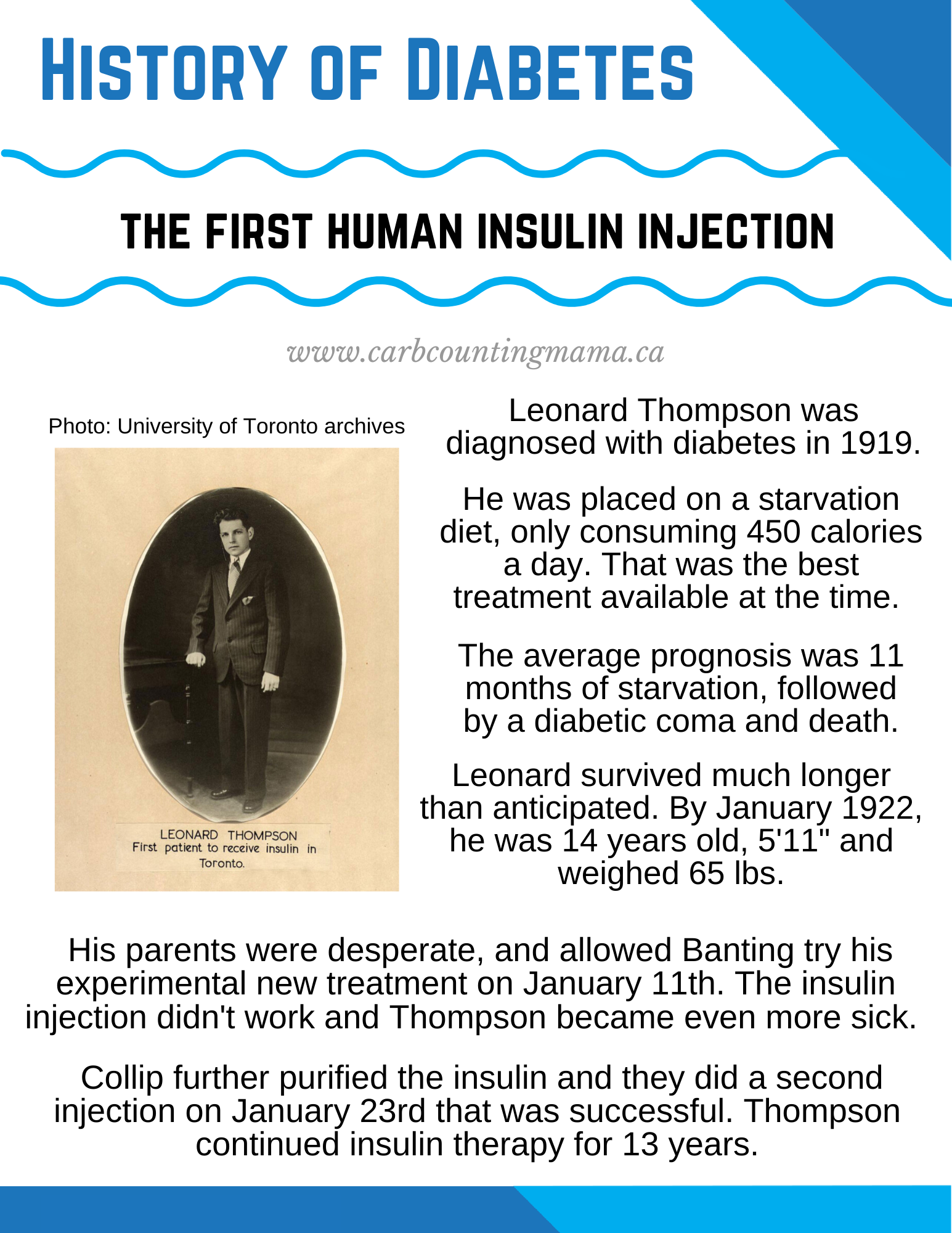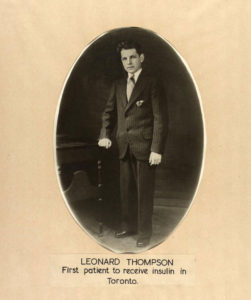
January 23rd is one of the most significant dates in the history of diabetes, and even the history of medicine. On January 23rd, 1922, the first successful dose of insulin was given to a patient.
Dr. Walter Campbell specialized in diabetes care and founded the diabetes clinic at Toronto General Hospital. On January 23rd, 1922, Dr. James Collip provided a more purified extract to Dr. Campbell to use on his patient, Leonard Thompson.
Thompson received a 5 cc injection, followed by another 20 cc injection of the extract. The next day, Leonard received 2 more 10 cc injections and his glycosuria almost disappeared.
But, this wasn’t the first time insulin had been tested on humans.
The first people to try insulin
First, let’s back up a bit to November 1921.
There is a rumor that Banting and Best injected each other with 1.5 cc of insulin. While I’ve personally never come across proof that Best received an injection of insulin, there is an entry in one of Banting’s notebooks that says:
“10:00 AM/ One of us (F.G.B.) had 1 1/2 cc Birk. ext subcut No reaction.”
Nov. 23, 1921: https://insulin.library.utoronto.ca/islandora/object/insulin%3AN10010
Now, Best and Banting were giving around 10-12 cc of the extract to the dogs they were experimenting on, so it’s no surprise that 1.5 cc had no effect on a grown man. It’s still quite interesting to think that he tried it on himself long before he felt it was ready for his patients.
Almost a month later, Banting administered insulin to someone else.
Dr. Joseph Gilchrist was a friend and former classmate of Dr. Banting. Dr. Gilchrist specialized in diabetes and, ironically, in March of 1917, he was diagnosed with the deadly disease.
In late 1921, Gilchrist heard about Banting’s research. He contacted Banting, pleading to try the extract. Banting refused, saying it wasn’t ready for human use.
Gilchrist didn’t give up. He showed up on Banting’s doorstep and begged to have the extract. He had to sign a waiver and was given insulin orally, via a stomach tube. As we know, insulin doesn’t work orally. It had no beneficial results for Gilchrist.
Clinical Use, Dec. 20. Phoned Joe Gilchrist – gave him extract that we knew to be potent. – by mouth. empty stomach.
Dec. 21 – no beneficial result.
Dec 20, 1921: https://heritage.utoronto.ca/exhibits/insulin
1922 and Leonard Thompson
Leonard Thompson was diagnosed with diabetes in 1919. He was only 11 years old. At the time, diabetes was a death sentence. Thompson’s prognosis was a mere 11 months.
A Starvation Diet ~ The next best thing
Thompson was put on the only known treatment for diabetes, a starvation diet. He was consuming 450 calories a day.
The Allen Starvation Diet, created by Dr. Frederick Madison Allen, was a very strict diet. The patient had to begin by fasting until there was no longer glucose in their urine. Then, they were put on a diet of vegetables that were boiled 3 times, with a small amount of fat and protein.
The diet also included 1 1/2 ounces of whiskey occasionally to increase calories. The whiskey also helped make patients feel more comfortable as they were constantly starving.
When the patient again tested positive for glucose in their urine, they’d have to fast and start the cycle again.
Leonard Thompson’s diet mostly consisted of small amounts of lean meat, grapefruit, and vegetables.
This diet prolonged Thompson’s inevitable death, but it wasn’t a cure. His parents were watching him slowly waste away.
Right place, right time
Luckily for Leonard and his family, he outlasted his dire prognosis of 11 months. For almost 3 years he survived on the starvation diet.
In January of 1922, he was 14 years old and weighed only 65 pounds.
He had been admitted to the Toronto General Hospital. He was in the end stages of diabetes. Leonard was close to a diabetic coma, his hair was falling out, and he looked like a skeleton. His parents, Harry and Florence, were desperate, but doctors told them there was no hope.
A miracle
It just so happened that at the same time, at the University of Toronto, Dr. Frederick Banting was working on his discovery. He had had successful trials in dogs, and was ready to move on to human subjects.
Leonard Thompson’s father allowed his son to be the first person to try Banting and Best’s pancreatic extract, which they called insulin.
On January 11th, 1922, Leonard became the first person to get an insulin injection. It did reduce his blood sugar level some, from 440 mg/dL (24.4 mmol/L) to 324 mg/dL (18mmol/L)*. However, Leonard’s ketones were unaffected by the insulin.
The insulin was not purified enough and it caused an abscess that almost killed Leonard.
A second attempt
Chemist James Collip worked tirelessly to further purify the extract.
On January 23rd, 1922, they tried again with Collip’s new insulin.
This time, Leonard’s blood glucose went from 520 mg/dL (28.8 mmol/L) all the way down to 120 mg/dL (6.7 mmol/L)*. His ketones vanished. And his symptoms gradually improved.
They continued insulin therapy in the hospital for 4 months. Leonard was able to go home in May 1922.
* The above blood glucose numbers were taken (and converted) from Dr. Banting’s actual notes. You can see some of his notes about Leonard Thompson here (if you can decipher his handwriting!)
13 more years

Leonard was put on a permanent insulin regimen. He lived a fairly normal life, growing up to be a clerk for a drug company.
He used insulin for his diabetes until April 20, 1935, when he passed away from pneumonia. Leonard was 27 years old. His pneumonia was thought to be a complication of his diabetes.
Yes, January 11th is an important date in the history of diabetes
But, if it wasn’t for Collip figuring out how to purify insulin, the 11th would be nothing significant.
It would have been lost. Along with the many, many other physiologists who were working on how to extract insulin. Along with the people who had breakthroughs decades before Banting’s “lightbulb moment”.
The discovery of insulin was, and still is, one of the most remarkable discoveries in modern medicine. It saves millions of lives on a daily basis and has for 100 years now.
But, if there’s a date to be acknowledged and celebrated, it’s January 23rd, not the 11th.
January 23rd, the day that insulin saved Leonard Thompson’s life. And everyone with T1D who came after him.
Did you learn something new from this article? I know I learned some new stuff while researching it. If you know of something interesting about the history of T1D, let me know in the comments!
For more tips and stories about T1D, join the Carb Counting Mama email list, and make sure to head over to the Carb Counting Mama Facebook page and “like” it.

What was the insulin regimen when Leonard T. was treated? Once a day? How many unites he took every day and at the beginning of the therapy? Was it dog insulin? or bovine? Does anyone know?
I’m not sure what the long term regimen was. There is a link in the article to Dr. Banting’s actual patient notes that you can take a look at. It seems that Thompson got one dose a day for the most part, but it was measured in CCs not units and I’m not sure if it was the same every day or not. Dog insulin was what Dr. Banting and his associates first experimented with. They actually removed pancreases from dogs and isolated the insulin and found a way to extract it and use it for humans. Bovine is the same but with cows instead of dogs (they got much more insulin from cows). Hopefully that helps!
Thank you for your research. I am very proud of my Uncle and Grandparents.
It is never noted anywhere but Leonard had a motorcycle accident that really lead to his death.
Penny V Parrish
Daughter of Mabel Pearl Thompson Parrish and niece of Viola Thompson Daines who was the oldest and a great story teller.
And niece to Leonard.